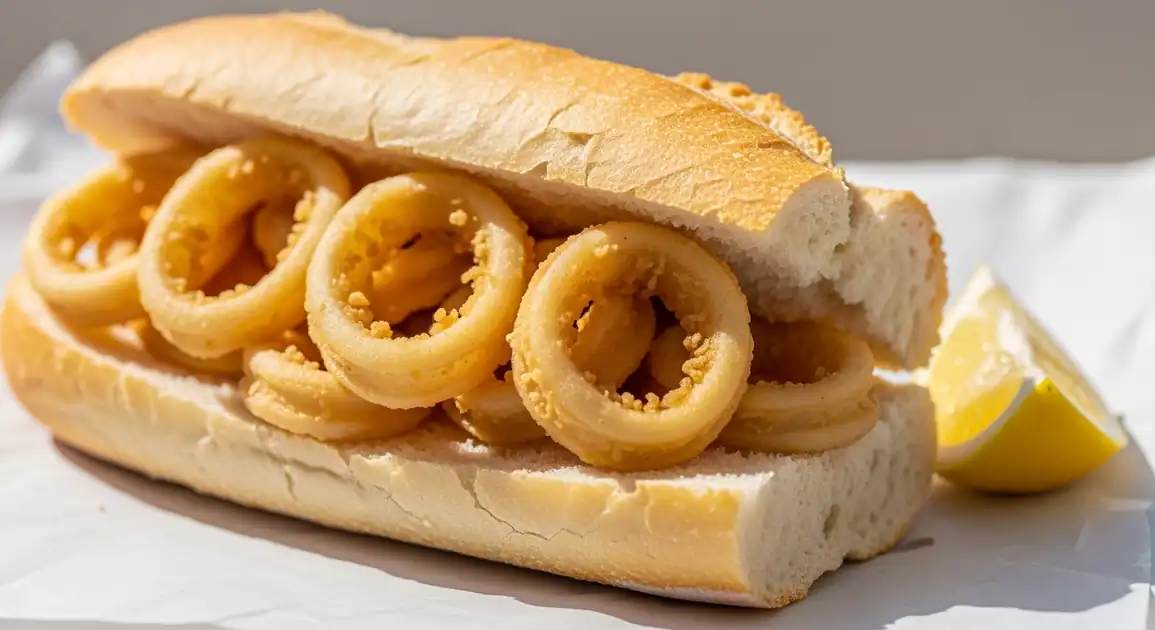Bocadillo de Calamares (Fried Squid Sandwich)
Bocadillo de Calamares

Description
In Madrid, Bocadillo de Calamares transcends mere street food to become a culinary emblem of the city, particularly around Plaza Mayor and Sol areas. Despite being landlocked, Madrid's historic connection to fresh seafood transportation has made this crispy squid sandwich a quintessential Madrileño experience, with certain establishments achieving legendary status for their versions.
Dietary Information
Serving information
Serving style
In Madrid, traditionally served on wax paper or small plates at the bar. Sometimes wrapped in paper for takeaway. Typically accompanied by lemon wedges. Best establishments serve on clean paper for each order.
Quick facts
Standard bars: 9 AM - midnight. Famous establishments like Bar El Brillante: often open until 2 AM or later. Mercado de San Miguel: typically 10 AM - midnight (later on weekends).
Safety Tips
What to Look For
-
Calamari fried fresh to order
Fresh frying ensures food safety and optimal texture. Listen for the sizzle of squid hitting hot oil when you order.
-
Busy establishments with high turnover
Popular places cycle through ingredients quickly, meaning fresher calamari and reduced time for potential contamination.
-
Clean oil that's clear and not dark or smoking
Quality oil produces better-tasting, less greasy calamari and indicates good kitchen practices.
-
Crispy, golden-brown calamari (not pale or too dark)
Proper cooking ensures food safety while maintaining tender texture. Pale indicates undercooking, too dark suggests old oil.
-
Fresh bread with a good crust
Quality bread elevates the sandwich and indicates attention to detail throughout preparation.
What to avoid
-
Pre-fried calamari sitting under heat lamps
Squid that's been sitting out becomes tough and rubbery while potentially allowing bacteria growth.
-
Greasy, oil-soaked bread
Excessive oil indicates improper frying temperature or poor draining technique, affecting both safety and taste.
-
Fishy smell from the calamari
Fresh squid should have a neutral, oceanic smell. A strong fishy odor indicates old seafood.
-
Empty restaurants during peak meal times
Low customer volume can mean ingredients sit longer before being used.
-
Rubbery, chewy texture in the squid
Indicates overcooking or poor-quality frozen squid, suggesting general lack of attention to quality.
Price information
Price range
Budget tips
- Prices near Plaza Mayor and other tourist spots can reach 7-8.50 EUR.
- Traditional bars in neighborhoods like La Latina or Lavapiés offer better value (3.50-5 EUR).
- Some bars offer a 'half portion' (medio bocadillo) for less.
- Look for 'Menu del Día' that might include a calamari sandwich with drink for a set price.
- Bar El Brillante and Bar La Campana are famous but reasonably priced despite their reputation.
Value indicators
- Generous filling of freshly fried squid.
- Crispy exterior on the calamari, tender inside.
- Fresh, crusty bread that's not overly thick.
- Served hot and fresh rather than pre-made.
- Clean frying oil (not dark or smelling overly used).
Where to Find This Dish
Plaza Mayor Area
The epicenter of Madrid's calamari sandwich culture, with several historic establishments.
Bar La Campana, Mercado de San Miguel, Plaza Mayor
Lunch (1 PM - 3 PM), Evening (7 PM - 10 PM)
Atocha/Recoletos
Area around the train station famous for Bar El Brillante and its award-winning calamari sandwiches.
Atocha Station, Bar El Brillante
All day, Late night (after 11 PM)
La Latina
Traditional neighborhood with authentic bars serving excellent versions away from the main tourist spots.
Calle Cava Baja, Mercado de la Cebada
Sunday afternoon, Lunch (1 PM - 3 PM)
Mercado de San Miguel
Gourmet market with several vendors offering upscale versions.
Mercado de San Miguel
Afternoon (12 PM - 6 PM), Evening (6 PM - 9 PM)
Vendor Tips
- Bars with a queue of locals are usually worth the wait.
- Avoid places advertising 'tourist menus' alongside calamari sandwiches.
- Places displaying 'Especialidad de la Casa' for their calamari often take pride in their version.
- Establishments with decades of history (e.g., 'Desde 1961') typically maintain traditional quality.
How to Order
Regional Variations
-
Plaza Mayor Style
(Estilo Plaza Mayor)
The classic Madrid style: generous portion of lightly battered calamari in crusty bread, minimal additions. Bar La Campana near Plaza Mayor is the archetype.
-
Atocha Style
(Estilo Atocha/El Brillante)
Named after the famous Bar El Brillante near Atocha Station, featuring slightly thicker batter and often served quartered with lots of lemon.
-
Gourmet Variants
(Versiones Gourmet)
Modern interpretations found in upscale tapas bars or Mercado de San Miguel, sometimes featuring black squid ink in the batter, artisanal bread, or house-made aioli.
-
Squid Ink Version
(Con Tinta de Calamar)
A distinctive Madrid variation where the batter or bread incorporates squid ink for a black appearance and more intense seafood flavor.
Cultural context
History
This humble sandwich emerged as a popular offering in Madrid's taverns and bars during the mid-20th century, particularly in areas near Plaza Mayor. Originally a convenient, affordable meal for workers, it evolved into an emblematic dish of Madrid's food culture. While seafood might seem surprising in landlocked Madrid, the city has historically received fresh seafood from coastal regions, with squid becoming a particularly beloved ingredient. Today, the Bocadillo de Calamares is considered one of Madrid's quintessential culinary experiences, representing the city's unpretentious approach to good food.
Local significance
The Bocadillo de Calamares is to Madrid what the cheesesteak is to Philadelphia—a defining culinary symbol. It represents Madrid's unpretentious attitude toward good food and the city's historical relationship with bringing seafood inland.
Eating customs
- Madrileños typically eat it standing at the bar with a caña (small beer).
- Adding just a squeeze of lemon is the authentic way; asking for extra sauces marks you as a tourist.
- In traditional bars, you might see the paper wrapper discarded on the floor—this is (or was) normal practice.
- Often ordered as a shared item among friends before continuing a tapas crawl.